You can either watch Sky TV through Sky Glass or through a Sky Q box. Compare the two ways of watching Sky TV.
 In the UK, there are now two different ways of watching Sky TV: you can either buy a Sky Glass television or you can get a Sky Q box for your existing TV.
In the UK, there are now two different ways of watching Sky TV: you can either buy a Sky Glass television or you can get a Sky Q box for your existing TV.
If you choose a Sky Glass television, you’ll be receiving live TV through your home broadband connection. There’s no need for a separate box or satellite dish as everything is built-in directly to the TV. You’ll also get HD included as standard. You won’t, however, be able to record TV: you’ll need to use the Sky Glass playlists feature instead. There are also fewer channels available on Sky Glass, with certain channels only available on the Sky Q box.
In this article, we’ll compare the two ways of watching Sky TV: via Sky Glass and via the Sky Q box. We’ll also compare the channels available and how much it costs. We’ll then look at the picture quality available, how playlists compare to recordings and how the multiscreen viewing feature works.
Contents
Sky Glass vs Sky Q: At A Glance
 In the UK, if you’re looking to watch Sky TV, there are now two different ways of getting it. You can watch Sky through the Sky Glass TV or through the Sky Q box.
In the UK, if you’re looking to watch Sky TV, there are now two different ways of getting it. You can watch Sky through the Sky Glass TV or through the Sky Q box.
If you choose Sky Glass, this will require you to buy a new TV. However, everything will be built directly into the television: there’s no need for a separate dish or box. In contrast, Sky Q works with your existing TV but it uses a satellite dish and a separate Sky Q box.
As the Sky Glass TV only requires you to have a broadband connection, it’s available in around 98% of UK homes (there’s a minimum required download speed of 10Mbps). Meanwhile, the Sky Q box uses a satellite dish for live television so you can get it anywhere in the UK as long as you’re able to install a dish.
The following table shows a side-by-side comparison of Sky Glass and Sky Q:
| Sky Glass | Sky Q | ||
|---|---|---|---|
 |
|||
| Television Set: | Small 43″ Medium 55″ Large 65″ |
Use your existing TV | |
| Channels: | Up to 140 channels | 300+ channels | |
| Features | |||
| Includes Netflix: | Yes | Yes (with Ultimate TV) | |
| Picture Quality: | HD (standard) Ultra HD 4K (with £5 add-on) |
SD (standard) HD (with £6 add-on) Ultra HD 4K (with £10 add-on) |
|
| Apps: | Yes | Yes | |
| Recording: | No, use playlists instead | Yes, up to 500 hours | |
| Multiscreen: | With Sky Stream Pucks | With Sky Q Mini boxes | |
| Technology | |||
| Reception Method: | Internet (broadband required) |
Satellite Dish (plus internet for on-demand & apps) |
|
| Requires Box: | No | Yes | |
| Requires Broadband: | Yes 10Mbps for HD 25Mbps for UHD |
No for live TV (required for on-demand & apps) |
|
| Availability: | 98% of UK homes Check availability → |
Most UK homes Check availability → |
|
Sky Glass & Sky Q Channels
 Whether you’re using Sky Glass or Sky Q, you’ll have access to the most popular UK channels included within your Ultimate TV plan. This includes BBC, ITV, Channel 4, Channel 5 and Sky TV entertainment channels. You’ll also get popular documentary channels included on both such as Discovery, National Geographic and more.
Whether you’re using Sky Glass or Sky Q, you’ll have access to the most popular UK channels included within your Ultimate TV plan. This includes BBC, ITV, Channel 4, Channel 5 and Sky TV entertainment channels. You’ll also get popular documentary channels included on both such as Discovery, National Geographic and more.
Where the Sky Q box has a slight advantage is in the total number and breadth of channels. Whereas Sky Glass only supports up to 140 channels, Sky Q includes more than 300 channels within the basic TV subscription. You can see a list of some of the channels that are missing on Sky Glass.
You’ll also get a Netflix Basic membership included with Ultimate TV, both on Sky Glass and on Sky Q. On Sky Glass, you’ll need to pay £4/month to upgrade to Netflix Standard (HD on two devices) and £8/month to upgrade to Netflix Premium (Ultra HD on 4 devices). On Sky Q, you’ll pay £6/month to upgrade to Netflix Standard (this also includes Sky TV channels in HD) and £10/month to upgrade to Netflix Premium (this also includes Sky TV channels in Ultra HD).
Picture Quality
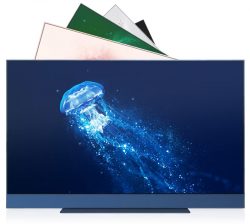 The biggest difference between Sky Glass and Sky Q is how the television pictures are delivered into your home. With Sky Glass, all of your television channels are delivered over the internet. In contrast, Sky Q uses a satellite dish for live TV.
The biggest difference between Sky Glass and Sky Q is how the television pictures are delivered into your home. With Sky Glass, all of your television channels are delivered over the internet. In contrast, Sky Q uses a satellite dish for live TV.
With Sky Glass, you’ll need a broadband connection with a minimum download speed of 10Mbps. However, it’s important to remember that your home broadband connection is shared with other users in your home (for instance, if someone else is studying or working from home at the same time). If you’re using a slow broadband connection, you may experience buffering and poor picture quality on Sky Glass.
It’s also important to think about resilience and broadcast delays.
With Sky Glass, everything relies on your broadband connection. For this reason, if your broadband service were to be disrupted for any reason, you’ll also lose access to your live TV (unless you were to connect it to an aerial and use the backup Freeview tuner). With Sky Q, your live TV channels are received over a satellite connection so they won’t be affected by disruption to your home broadband service.
 Broadcast delays can be another potential issue on Sky Glass. As all of your live TV is streamed over the internet, you might experience a delay of up to 45 seconds before the broadcast is shown on your TV. In other words, if you’re watching football, you might see the goal happening up to 45 seconds late. In contrast, the delay on your Sky Q box will normally be no more than 1-2 seconds as it uses satellite technology.
Broadcast delays can be another potential issue on Sky Glass. As all of your live TV is streamed over the internet, you might experience a delay of up to 45 seconds before the broadcast is shown on your TV. In other words, if you’re watching football, you might see the goal happening up to 45 seconds late. In contrast, the delay on your Sky Q box will normally be no more than 1-2 seconds as it uses satellite technology.
Leaving aside those potential differences, both Sky Glass and Sky Q can deliver up to Ultra HD (4K) HDR picture quality. You’ll get HD quality viewing as standard on the Sky Glass, with the option to upgrade your Sky TV channels to Ultra HD for an extra £5 per month. Meanwhile, you’ll only get SD quality viewing included as standard on Sky Q. You’ll have the option to upgrade to HD for an extra £6 per month or Ultra HD for an extra £10 per month.
| Sky Glass | Sky Q | |
|---|---|---|
| Sky TV Picture Quality: | HD (included) Ultra HD (£5 per month) |
SD (included) HD (£6 per month) Ultra HD (£10 per month) |
| Netflix Picture Quality: | SD (included) HD (£4 per month) Ultra HD (£8 per month) |
Same as Sky TV channels (included above) |
It’s worth noting that the HD and Ultra HD upgrades on Sky Q also include an upgrade to your Netflix plan. On Sky Glass, you’ll need to pay to upgrade your Netflix plan separately.
Playlists & Recordings
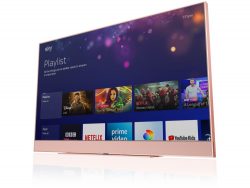 If you’re moving from Sky Q to Sky Glass, you’ll lose the ability to record live TV. You’ll also no longer be able to store recordings on your own box.
If you’re moving from Sky Q to Sky Glass, you’ll lose the ability to record live TV. You’ll also no longer be able to store recordings on your own box.
In place of the ability to record, Sky Glass has introduced cloud-based playlists. With playlists, you can mark your favourite shows and movies. Sky Glass will then search through all of your video-on-demand services to find it (including Netflix, Amazon Prime Video, Disney+, BBC iPlayer, ITV Hub, All4 and more). If applicable, you’ll then be able to watch it through the relevant on-demand service.
One advantage of playlists is that you won’t need to schedule recordings in advance. However, it also takes a lot of control away from you as the on-demand streams will be subject to relevant rights agreements (e.g. they might disappear after 7 days or after 30 days). In addition, if it’s only available to watch on a paid service like Prime Video or Disney+, you’ll need to have a subscription to that service as well to watch.
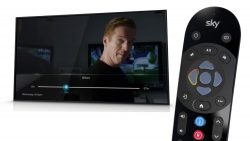 With Sky Q, you’ll able to schedule your own recordings. Normally, you’ll also be able to keep them for as long as you like. That’s because the recordings are stored on a hard drive inside your Sky Q box. This gives you a lot more control. There’s also no need to maintain a subscription to the relevant on-demand service to watch.
With Sky Q, you’ll able to schedule your own recordings. Normally, you’ll also be able to keep them for as long as you like. That’s because the recordings are stored on a hard drive inside your Sky Q box. This gives you a lot more control. There’s also no need to maintain a subscription to the relevant on-demand service to watch.
| Sky Glass | Sky Q | |
|---|---|---|
| Supports Recording: | No, use playlists instead | Yes |
| Storage: | – | Up to 500 hours |
| Video On Demand: | Yes (via playlists & apps) | Yes (via apps) |
| Pause Live TV: | Yes |
Yes |
Multiscreen Viewing
 Both the Sky Glass and Sky Q support multiscreen viewing.
Both the Sky Glass and Sky Q support multiscreen viewing.
On Sky Glass, you’ll pay an extra £10 per month to add the Whole Home pack. There’s also a £50 upfront fee for each Sky Stream Puck (unless you’re an existing Sky TV customer, in which case, the first Puck will be free). The Sky Stream Puck gives you the Sky TV experience on another screen. You can plug it in to your TV using a HDMI connection and it can support up to 4K HDR picture quality. The additional Sky Stream Pucks will also use your broadband connection: you’ll need an extra 5Mbps for each Puck on your home network.
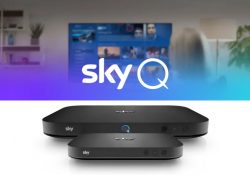 On Sky Q, you can pay an extra £15 per month to add the Multiscreen service. This includes a Sky Q Mini box and access to Sky Go Extra. The Sky Q Mini box allows you to watch Sky TV on an additional screen. You can have up to four Sky Q Mini boxes in your household, in addition to the main Sky Q box. Additional boxes are limited to HD quality viewing and lack the ability to record (though you can schedule recordings and play them back from the main Sky Q box).
On Sky Q, you can pay an extra £15 per month to add the Multiscreen service. This includes a Sky Q Mini box and access to Sky Go Extra. The Sky Q Mini box allows you to watch Sky TV on an additional screen. You can have up to four Sky Q Mini boxes in your household, in addition to the main Sky Q box. Additional boxes are limited to HD quality viewing and lack the ability to record (though you can schedule recordings and play them back from the main Sky Q box).
| Sky Glass | Sky Q | |
|---|---|---|
| Multiscreen Price: | £10 per month | £15 per month |
| Multiscreen Device: | Sky Stream Puck (Ultra HD) | Sky Q Mini (HD) |
| Number of Devices: | Up to 3 Sky Glass TVs Up to 6 Sky Stream Pucks |
1 Sky Q box (main) Up to 4 Sky Q Mini boxes |
More Information
You can see Sky’s official UK website for more information about the Sky Glass TV and the Sky Q box.
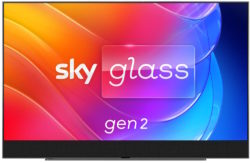
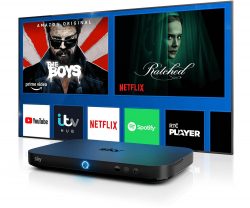
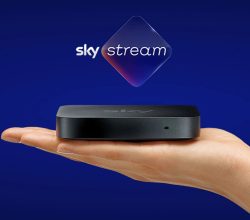
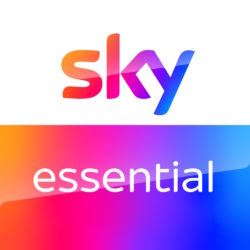
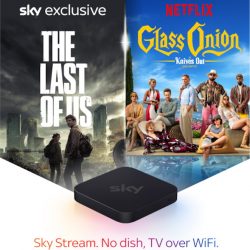


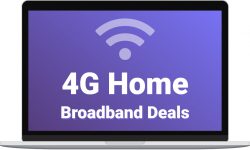

Dj Mccarthy said:
don’t sky have an issue with itv…so the glass TV directs u to the itv player app. to be honest I have q and love it this just feels like a smart TV with now TV added..a backward step
Judy Joyce said:
If ‘recordings’ for BBC are only available via iPlayer, surely there is a wait to watch these as currently they are not available instantly?
Peter Evans replied:
And they’re often only available for a limited time.